Not long ago, I discovered Doomlings. The game has all the hallmarks of a winner: easy to learn, quick to play, a constant sound of giggling by the players. The game is a lot of fun!
Playing Doomlings
Doomlings is a card game. Although you can get/use community play mats, individual player mats, first player tokens, and the like, all that is needed to play are the cards. The base game of Doomlings has three types of cards: Ages, Traits, and Gene Pools.
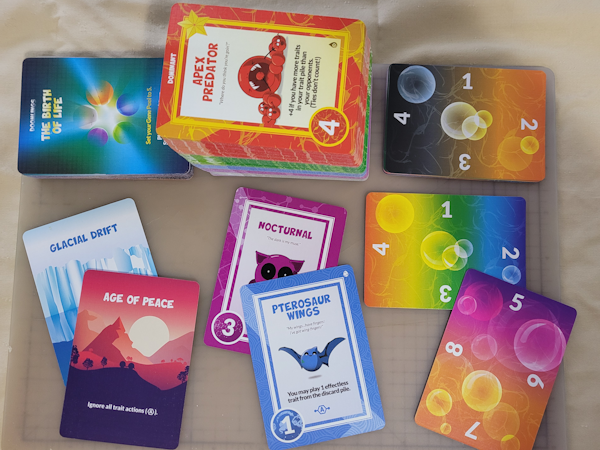
Setup
Ages are the game’s timer. There are three types of ages: the Birth of Life card, the standard ages and the catastrophes.
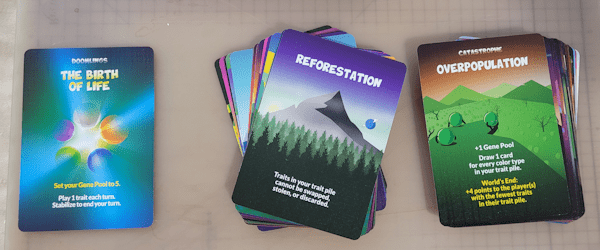
You start by shuffling the standard ages together and then dealing them face-down into three piles of three (nine cards); put the rest of the standard ages back in the box. Then shuffle the catastrophes together and deal one onto each of the three piles of standard ages (three cards); put the rest of the catastrophes back into the box. Each of these three piles of four cards is shuffled individually, then stacked. Last, place the Birth of Life card face-down on top of this stack. The Ages Deck (which should have 13 cards) is complete.
Traits are the cards players will play. Traits come in four colors (and colorless), and in two types: standard traits, and dominant traits. Dominant traits have a big star on them – a player cannot have more than two Dominant traits in play.
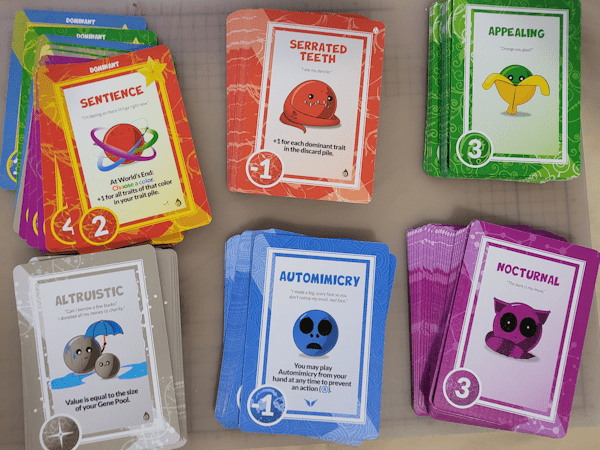
All the traits cards are shuffled and placed into the middle of the table as the Traits Deck. A randomly selected player is chosen as the dealer and deals five cards out to each player.
Gene pool cards are used to keep track of a player’s hand-size limit. These cards have the numbers 1 through 4 on one side, and 5 through 8 on the other. A player’s gene pool can never be lower than 1 or higher than 8. Each player takes one of these cards and sets it in front of them, set to the number 5.
Play is ready to begin.
A Look at the Trait Cards
Trait cards come with a bit of info on them. A basic trait has just four elements in addition to the color/pattern on the frame:
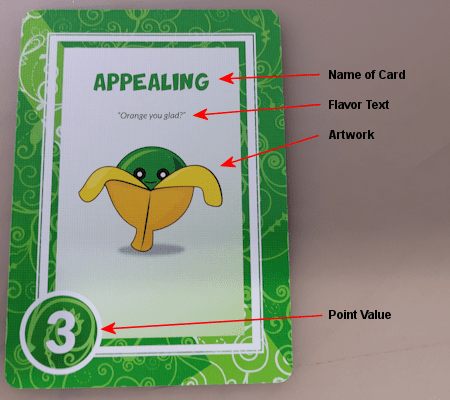
If a trait has an effect, it will appear under the artwork. Effects include bonus points, effects that are triggered at World’s End, or actions that are to be taken when the card is played. In each case, there is an icon on the trait to indicate what type of effect it has.
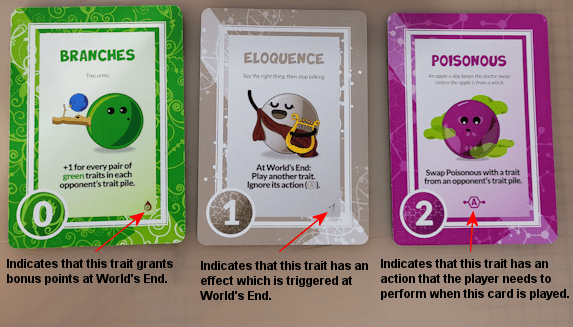
Lastly, there is a symbol on some cards that indicate that the card can be played outside the normal turn sequence.
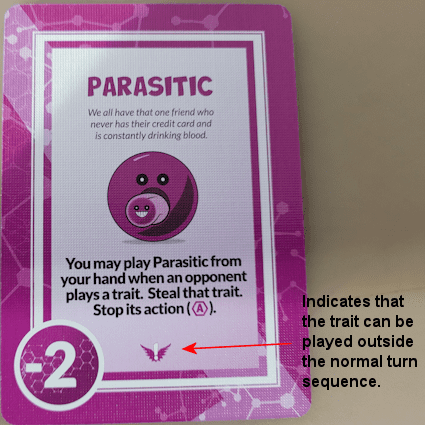
Playing the Game
The first player is the one left of the dealer. That player starts by flipping over the Birth of Life card on the Ages Deck.
On each player’s turn, they will select one card from their hand and play in front of them (i.e., into their Trait Pile). If the trait played has instructions (below the artwork) the player will do whatever the card tells them to do.
After they have played and resolved their card, they stabilize: they check the number of cards in their hand and compare it to their current Gene Pool value, adjusting their hand size to match. Play then passes clockwise.
If play passes to the current first player, that player flips the next card of the Ages deck. This card can have immediate instructions, or an effect that lasts until the next age. If the card flipped is a catastrophe card, then things can be shaken up even more!

Each catastrophe card has an indicator telling the players this is a catastrophe, a name (just like the standard ages), and three effects listed on it: a Gene Pool effect, a catastrophic effect (similar to the effects of standard ages) that lasts for the next round, and World’s End effect.
When a catastrophe is revealed, the first player is shifted to the left, players adjust their Gene Pools as instructed, then the catastrophic effect is applied. Only if this is the third and final catastrophe of the game is the World’s End effect applied. If it is, apply the effect and the game immediately ends.
After that third catastrophe, players count up their points.
The player with the highest score wins. In the case of a tie, each tied-player (in turn order) draws one card from the Trait Deck and adds the face value of that card to their score.
Thoughts
The Good
Doomlings is a fun little game that players catch on to pretty quickly. In our first session, the teach took about five minutes and there were only a couple of questions. Everyone had a great time! In all the subsequent games, nobody had any questions—the game is really quite straightforward. With each play, however, the level of fun began to taper off.
Simplicity
The straight-forwardness of the game is its greatest strength. You can pick it up and be in the middle of a game pretty quickly. The rules just make sense. After a single turn, you have a really good idea as to how the game works, and what you want to look for to complement the cards you have in play.
Cuteness
Do not underestimate the allure of cuteness in game design. I think that games like My Little Scythe and Everdell are great games that sell far more than they otherwise would simply because of just how darned cute they are. One of the best parts of Doomlings is announcing the card you are playing and reading the flavor text out loud. The rules of the game do not tell you to do this, but it quickly became an unwritten rule for us. Sometimes I caught myself playing a less-valuable card just so I could read the flavor text; it is very often that good.
The Bad
Doomlings is not a perfect game. It has some areas that can get in the way of it being a real contender.
Simplicity
As much as simplicity and straight-forwardness are the game’s greatest strength, these adjectives also describe the game’s greatest weakness. Gameplay of Doomlings is so basic that there are very few tough choices to make. In a turn, you look at your hand and play the trait that benefits you most (usually the one worth the most points). Then you do what the card tells you to do and pass your turn. There are very few times when you will have a trait that is not worth many points (or is potentially worth negative points) and the advantage of playing that card is not obvious.
This dichotomy cannot be overstated. There is enough fun involved here to tickle anyone’s fancy; there is not enough decision space to keep a serious gamer interested for more than a couple of games at a time. As an appetizer, a palate cleanser, or a desert, this game is wonderful! But I cannot ever see this being the main course of the evening.
Counting Cards
This game has traits in four colors (blue, green, purple, and red) as well as some that are colorless (printed in a gray tone). One would think that the number of blue traits would be the same as the number of green traits, and so on. Sure, colorless traits can be given a pass—they can have less, the same, or more cards without feeling odd. Not only is the number of traits in each color not the same, the number of Dominant traits in each color is not the same either. I cannot for the life of me figure out any reason why this would be the case.
The Ugly
There are some choices that were made by the designers that go beyond bad. None of these impact game-play and, if you are not completist may not even impact you in any way. They are things that bug me enough to warrant letting you know.
Foil Cards?
In the game box (if you get the deluxe version), there are three random holofoil cards included. These duplicate normal cards that were included, so they can be ignored. But why have them? Is there someone out there buying multiple deluxe sets trying to collect a full set of foils? No, more likely there are many someones charging insane markups for foil singles in the secondary market.
This is not a collectable card game. If it were, what would be the point? Without a mechanism such as deck construction or the like, what would be the point of mimicking a collectable card game?
Colorblind? Tough.
This game has traits in four colors (blue, green, purple, and red) as well as some that are colorless (printed in a gray tone). The game has many cards that depend upon knowing what color a card happens to be, but the cards have nothing that would aid a colorblind person in recognizing what color a card happens to be. The patterns printed on the borders of the cards are far too subtle to make this work.
First Player
Doomlings is a game where you need to know who the first player is at all times. The deluxe game comes with no token or marker or other component to tell you who this is. Not a big deal, you can use just about anything for this purpose.
However, if you want to get an official first player marker, you have to go to the Doomlings webstore. Here you will find six designs for a first player marker (a 1.5 inch medallion). Each of these items will cost you $13.99 plus tax. The description of these items includes this tidbit:
Buy one 1st Player Medallion and pass it around the table to track who the 1st player is, or collect more so each player can keep one through the game, turning their medallion face-up when they become 1st player!
I really do not see spending $83.94 plus tax (plus shipping) to get a set of first player markers for a game of this weight. Yea, that would be a hard ‘no’ from me.
The Overlush Expansion
If you buy the deluxe version of Doomlings, it comes with several small expansions:
- Dinolings (18 cards): a set themed around dinosaurs. No new rules.
- Meaning of Life (18 cards): a set that introduces star signs that allow players to have secret goals.
- Multicolor (7 cards): a small set with traits that have two colors (and one that is four colors).
- Mythlings (19 cards): a set themed around mythical creatures. No new rules.
- Techlings (18 cards): a set themed around cybernetic organisms.Some rules for modifying traits.
Each of these expansions is interesting and fun. I like them all. My only complaint with them is that the number of traits in each color is neither equal nor are they correcting the number of traits in each color from the base game. But that is beside the point.
There is another expansion, however, that is not included in the deluxe version. This is the expansion Overlush Mystery. You cannot purchase this expansion. What you can purchase are mystery packs. Each mystery pack contains 15 cards: 7 common, 5 unusual, 2 scarce/endangered/legendary, and 1 random holofoil card.
This is a booster pack. You would have to spend several hundred dollars to collect all of the cards from this expansion (likely having to delve into the single-card market, paying insane markups). And to be honest, you would never really know if you were done. The Doomlings website will not tell you how many cards are in the set – it just says more than 170 cards. How many more? The secondary market suggests that the set has about 173 cards. That is the total number of traits in the deluxe set (base game plus all included expansions). Great! Problem solved.
Nope, there is still an issue. The base game includes cards that were designed to have duplicates (e.g., the green trait Swarm and the red trait Kidney both get more valuable the more of them that are in play). Were any of the cards in Overlush Mystery designed that way? Who knows. Even if a given card obviously is looking for others like it, how many are you supposed to include?
Again: there is no reason for a game like this to be treated as a collectable card game. None. The only people who benefit from this are the publisher who gets you to buy duplicate cards you neither need nor want, and those who sell such things as singles on the secondary market. Everyone else just gets screwed.
Final Thoughts
Yes, I have issues with some of the directions the designers have chosen. These are all issues that I can ignore, so they do not impact the final rating. In this review, I give Doomlings three stars. From a gameplay perspective, I believe this is fair. The game is fun, light, and does not overstay its welcome; but it feels a bit too light at times. While it seems the expansion material might provide variety, I can’t speak for added depth. If this game had some expanded decision space that allowed more agency beyond ‘select one of the cards in my hand’ then this game could easily move a star or two!


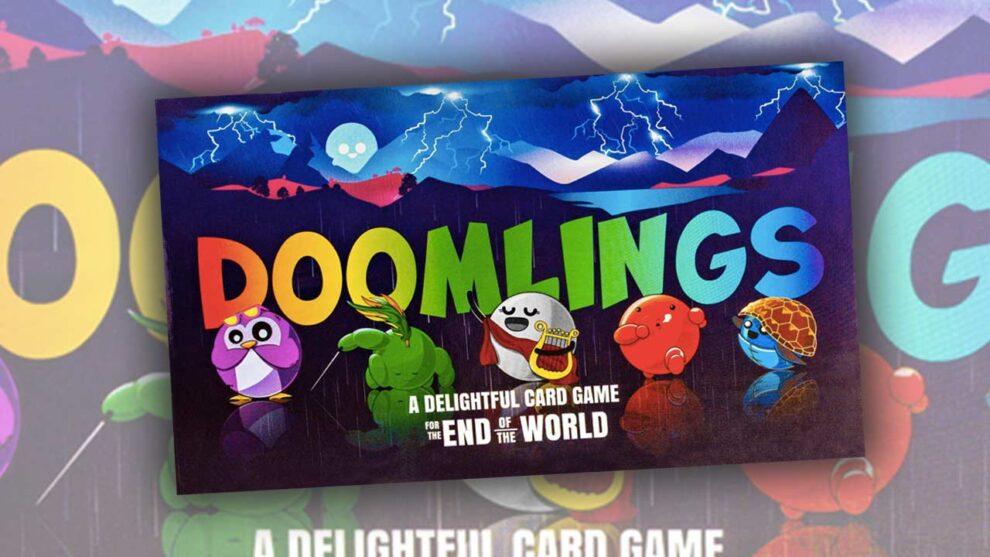

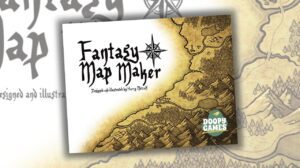
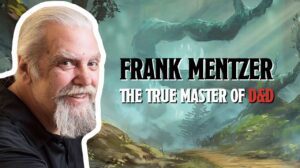
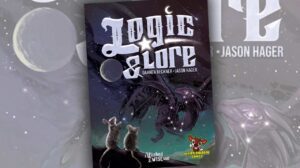





Add Comment